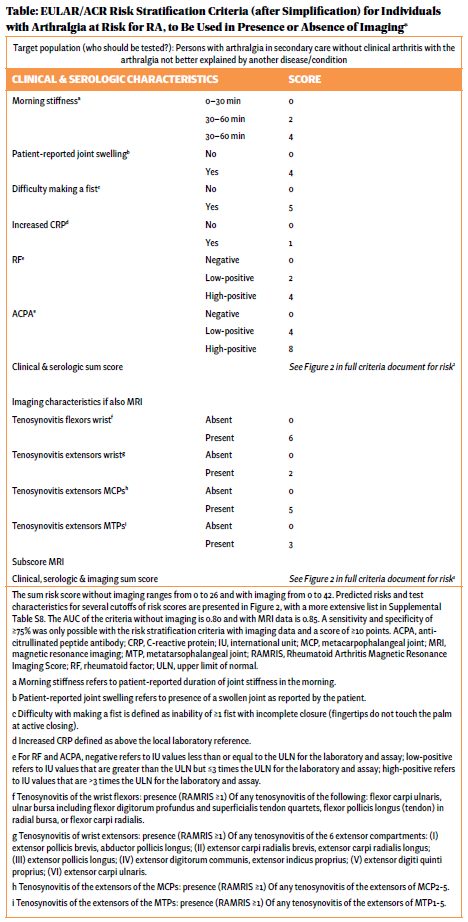 In recent years, researchers have begun exploring risk factors for the development of rheumatoid arthritis (RA), including via several interventional studies. New risk stratification criteria developed by EULAR and the ACR provide an important step toward evidence-based treatment approaches for at-risk patients, particularly for those already presenting with arthralgia.1
In recent years, researchers have begun exploring risk factors for the development of rheumatoid arthritis (RA), including via several interventional studies. New risk stratification criteria developed by EULAR and the ACR provide an important step toward evidence-based treatment approaches for at-risk patients, particularly for those already presenting with arthralgia.1
The Drive to Earlier Interventions
One of the participants in the recent project, Kevin D. Deane, MD, PhD, a professor of medicine in the Division of Rheumatology, University of Colorado, Aurora, notes that classification criteria already exist for people who have full-blown inflammatory arthritis that is clearly diagnosable as RA. Under current criteria, such a diagnosis requires, among other things, synovitis identifiable via physical exam in at least one joint.2
However, some individuals experience arthralgia with a clinical context suggestive of rheumatoid arthritis, but without overtly swollen joints. Other people have one or more factors that put them at risk for developing RA, such as positivity for anti-citrullinated protein antibodies (ACPA) or a first degree relative with the condition; some, but not all, also experience such arthralgia.
“We have established treatments to improve outcomes and quality of life in [patients with] RA, but very rarely are people ever cured and able to come off drugs,” says Dr. Deane. “The drugs are expensive and have toxicities, and over 50% of people don’t experience complete disease remission. So intervening at an earlier point and, hopefully, preventing disease could be greatly beneficial.”
One of the project leads is Annette H.M. van der Helm-van Mil, MD, PhD, a professor in the Department of Rheumatology at Leiden University Medical Center, The Netherlands. She notes that the disease may be more reversible at an earlier stage, before pathophysiological processes are fully established. Even in people for whom the disease may not be completely prevented, it could be delayed. Appropriate treatments may improve symptoms in people already experiencing joint pain and stiffness and reduce long-term joint damage.
Although overall results from interventional trials have been mixed, including negative trials for hydroxychloroquine and rituximab, some randomized controlled trials have already shown promise in this area. These include two positive trials for abatacept and a study of methotrexate that showed some benefit, especially in ACPA-negative patients.3-7
However, fully interpreting and comparing the results of these prevention trials is challenging, partly because researchers in the nascent field have defined and studied patients at risk for RA using somewhat differing criteria and approaches.
Trial Rigor
In 2021, a EULAR task force formulated key points to consider when designing research trials investigating patients at risk for RA. Led by Kulveer Mankia, MD, a professor of clinical and translational rheumatology at the University of Leeds, U.K., the task force came to consensus on many helpful considerations when designing trials in individuals at risk for RA, including different at-risk populations that could be studied and the outcome measures that could be used. However, slightly different predictive tools had been used by individual centers.8,9
“We lacked validation of the different individual predictive tools,” explains Dr. van der Helm-van Mil. “We didn’t have consensus on what variables should be tested.”
Several groups have already developed their own non-validated risk stratification tools, using prospective studies to identify factors that best predict the development of inflammatory arthritis and RA. However, these efforts have been limited due to sample size and the different biomarkers included by the different centers.10
To address these issues, EULAR formed an expert committee to develop an accurate and validated algorithm for risk stratification, which soon became a collaborative effort with the ACR. Importantly, the idea was to develop rigorous risk stratification criteria rather than true disease classification criteria (e.g., such as those used to promote patient homogeneity in studies of defined diseases).
“This is the first consensus on risk stratification criteria, combining data sets of different at-risk individuals from different countries and validating those previous efforts, providing a more robust risk stratification tool than we’ve previously had,” shares Dr. Mankia.
Dr. van der Helm-van Mil points out that although the field has initially focused on agents already approved for RA, the agents most helpful during an at-risk stage may be different from the ones that are already used to treat full-blown RA. Agents with early pathophysiological targets may be needed, requiring more drug development stages. Additionally, given the challenges of acquiring adequate individuals who are at-risk for future RA in studies, it’s essential that research in this area be of the highest quality possible.
“The risk stratification criteria will help harmonize efforts going forward in trials in this area,” says Dr. Mankia. “The key aim is an increased confidence of what the risk factors are, then taking that into trials by selecting the right individuals based on their risk status. Then we’re more likely to get valid results.”
The Criteria: Approach & Results
With this goal in mind, the expert committee pooled 10 different prospective, observational cohorts of people with arthralgias at risk for RA. None of the participants had clinically apparent inflammatory arthritis at the start of their respective studies. This specific pooled dataset and analysis also did not include patients who lacked symptoms of arthralgia but had other risk factors for RA. The pooled cohort, with data gathered from the Netherlands, Germany, Italy, Austria and the U.K., ultimately included almost 2,300 people.1
The primary end point was clinically apparent inflammatory arthritis in one or more joints, identified by physical exam. Dr. Deane points out that most rheumatologists would begin treatment for such patients if they saw them in clinic. Although this end point was technically defined in terms of inflammatory arthritis, due to inadequate study information to meet full classification criteria for RA in some cohorts, it’s assumed the majority would also clinically classify as having RA. Moreover, a second analysis with RA as an end point showed similar accuracy.
Ultimately, the main analysis included 24 potential clinical variables and serologic variables, although not every single variable was available in each individual—a challenge in combining cohort data. The team created a logistic regression model and a risk stratification model using the 24 clinical and serological variables and the primary end point outcome.
They used these findings to create a stratification method using six clinical and serological variables found to be strongly associated with the development of inflammatory arthritis. These were:
- Difficulty making a fist;
- Patient-reported morning stiffness;
- Patient-reported joint swelling;
- Increased C-reactive protein;
- Positive rheumatoid factor; and
- ACPA positivity.
Based on their respective predictive power, these were given different weights (e.g., four points for patient-reported joint swelling, five for difficulty making a fist, four points for low but positive ACPA, eight points for high-positive ACPA (see Table).
The team also analyzed 10 ultrasound and 12 magnetic resonance imaging (MRI) variables, to see if imaging could improve discriminatory ability. Their specific analysis did not find that ultrasound further enhanced detection, but adding MRI improved the ability to accurately predict inflammatory arthritis.
Thus, a patient’s risk stratification criteria can be assessed just using clinical and serological parameters (with risk scores ranging from 0 to 26). Alternatively, adding additional MRI criteria, where available, can further improve accuracy (risk scores ranging from 0 to 42).
Imaging is not available in all settings, and Dr. van der Helm-van Mil explains they wanted a set of risk criteria that could be widely employed. Moreover, they designed the risk stratification tools to put comparatively more statistical weight on clinical and serological factors compared to imaging. But they also added the second and fuller risk criteria including MRI features that could be used for increased accuracy, if desired.
In the pooled analysis, 17% of patients had progressed to inflammatory arthritis by one year. Patients could be distributed into low risk of progression (<25% risk), intermediate risk (25–75%) or high risk (75% or higher). Including the use of MRI along with clinical and serological variables, 85% of patients fell into the lowest risk group, and 4% fell into the high-risk group.
For future study design, a cutoff point of 10 or greater points in the simplified version of the risk stratification criteria would yield a sensitivity and specificity of greater than 75% (or 12 or greater in the version including MRI). However, the committee did not recommend a specific reference risk stratification score for use in future trials. Dr. Deane pointed out that depending on the specific pre-RA study (e.g., agents with lower vs. higher side effect profile), researchers may use different cutoff points for inclusion of individuals.
Imaging Caveats
The lack of inclusion of ultrasound in the final risk stratification criteria was an important source of discussion among the committee members. Ultrasound’s lower cost and greater availability provide advantages over MRI. Moreover, although ultrasound did not emerge as providing additional predictive power in this specific pooled analysis, several papers in different international cohorts have shown that it may be predictive of progression to RA, including work by Dr Mankia and colleagues.11-13
Dr. Mankia notes that bone erosions seen via ultrasound have been highly predictive of progression in previous cohort studies.11-13 MRI is more sensitive for inflammation than ultrasound, particularly tenosynovitis, which may also have been part of why it improved predictive capacity in this analysis, even though ultrasound did not.
Dr. Mankia argues that ultrasound may still have utility in this population, and future risk stratification might ultimately include it. “In clinical practice, ultrasound helps us understand why people present with pain and stiffness,” he says, “because we can see inflammatory changes on the scan. If we do see those changes, we will likely monitor that patient more closely, because it is a sign that they may be on the way towards developing RA imminently.”
Clinical Applicability
These risk stratification criteria were created using data from specific populations already in specialized secondary care, with the aim of improving rigor in future clinical trials. “It’s very important they be applied in the correct population,” emphasizes Dr. van der Helm-van Mil.
For example, she points out that a general practitioner would see comparatively more patients with osteoarthritis than those with arthralgia who might develop RA, and the risk criteria aren’t validated for that kind of setting. In other words, these criteria are not designed for use in the general population.
However, Dr. Deane notes that on a practical level, the tool may help inform rheumatologists’ clinical practice (e.g., during patient counseling with specific at-risk patients). “If this robust tool tells you that a person is high risk, that doesn’t mean you’ll want to use a specific therapy or make a diagnosis, but you might want to monitor them more closely,” he says.
Looking Forward
Researchers have been pursuing the goal of preventing full-blown autoimmune diseases in other settings as well. Dr. Deane points out that in the field of endocrinology, researchers have developed a therapy approved by the U.S. Food & Drug Administration, teplizumab, to delay the progression of type 1 diabetes in people who already have two positive anti-pancreatic islet antibodies but who don’t yet require daily insulin injections. Researchers are also studying it in the context of high-risk patients who don’t yet qualify for a diabetes diagnosis.14
“[These] RA risk classification criteria add to the overall push to intervene in people who are feeling unwell and seeking healthcare before they have overt joint swelling and classifiable rheumatoid arthritis,” says Dr. Mankia. “This is an incremental step toward earlier therapeutic intervention.”
The committee is working on a second aspect of the project expected to be released in 2026. In contrast to the present work, it will provide RA risk stratification criteria that can be used more at a population level in people who have one or more risk factors (e.g., first-degree relative or CCP positivity) but who have not presented to a healthcare provider with arthralgia or other musculoskeletal symptoms.
“It’s so exciting that we can even begin to predict future disease and try to prevent it,” says Dr. Deane. “Having [these] new risk stratification criteria is great because it’s moving us toward being able to do that better.”
 Ruth Jessen Hickman, MD, a graduate of the Indiana University School of Medicine, is a medical and science writer in Bloomington, Ind.
Ruth Jessen Hickman, MD, a graduate of the Indiana University School of Medicine, is a medical and science writer in Bloomington, Ind.
References
- van Steenbergen HW, Doornkamp F, Alivernini S, et al. EULAR/ACR risk stratification criteria for development of rheumatoid arthritis in the risk stage of arthralgia. Arthritis Rheumatol. 2025 May 8. Online ahead of print.
- Aletaha D, Neogi T, Silman AJ, et al. 2010 Rheumatoid arthritis classification criteria: An American College of Rheumatology/European League Against Rheumatism collaborative initiative. Arthritis Rheum. 2010 Sep;62(9):2569–2581.
- Gerlag DM, Safy M, Maijer KI, et al. Effects of B-cell directed therapy on the preclinical stage of rheumatoid arthritis: The PRAIRI study. Ann Rheum Dis. 2019 Feb;78(2):179–185.
- Deane KD, Striebich CC, Feser ML, et al. A phase 2 trial of hydroxychloroquine in individuals at risk for rheumatoid arthritis. Arthritis Rheumatol. 2025 Aug 29. Online ahead of print.
- Cope AP, Jasenecova M, Vasconcelos JC, et al. Abatacept in individuals at high risk of rheumatoid arthritis (APIPPRA): A randomised, double-blind, multicentre, parallel, placebo-controlled, phase 2b clinical trial. Lancet. 2024 Mar 2;403(10429):838–849.
- Rech J, Tascilar K, Hagen M, et al. Abatacept inhibits inflammation and onset of rheumatoid arthritis in individuals at high risk (ARIAA): A randomised, international, multicentre, double-blind, placebo-controlled trial. Lancet. 2024 Mar 2;403(10429):850–859
- Krijbolder DI, Verstappen M, van Dijk BT, et al. Intervention with methotrexate in patients with arthralgia at risk of rheumatoid arthritis to reduce the development of persistent arthritis and its disease burden (TREAT EARLIER): A randomised, double-blind, placebo-con-trolled, proof-of-concept trial. Lancet. 2022 Jul 23;400(10348):283–294.
- Mankia K, Siddle H, Di Matteo A, et al. A core set of risk factors in individuals at risk of rheumatoid arthritis: A systematic literature review informing the EULAR points to consider for conducting clinical trials and observational studies in individuals at risk of rheumatoid arthritis. RMD Open. 2021 Sep;7(3):e001768.
- Mankia K, Siddle HJ, Kerschbaumer A, et al. EULAR points to consider for conducting clinical trials and observational studies in individuals at risk of rheumatoid arthritis. Ann Rheum Dis. 2021 Oct;80(10):1286–1298.
- Duquenne L, Hensor EM, Wilson M, et al. Predicting inflammatory arthritis in at-risk persons: Development of scores for risk stratification. Ann Intern Med. 2023 Aug;176(8):1027–1036.
- Di Matteo A, De Lorenzis E, Duquenne L, et al. Ultrasound in anti-CCP+ at-risk individuals without clinical synovitis: development of a novel 6-joint protocol for feasible risk prediction. Rheumatology (Oxford). 2024 Aug 1;63(8):2213–2221.
- Di Matteo A, Mankia K, Duquenne L, et al. Ultrasound erosions in the feet best predict progression to inflammatory arthritis in anti-CCP positive at-risk individuals without clinical synovitis. Ann Rheum Dis. 2020 Jul;79(7):901–907.
- Ziegelasch M, Eloff E, Hammer HB, et al. Bone erosions detected by ultrasound are prognostic for clinical arthritis development in patients with ACPA and musculoskeletal pain. Front Med (Lausanne). 2021 Mar 23;8:653994.
- Herold KC, Bundy BN, Long SA. An anti-CD3 antibody, teplizumab, in relatives at risk for type 1 diabetes. N Engl J Med. 2019 Aug 15;381(7):603–613. Erratum in N Engl J Med. 2020 Feb 6;382(6):586.



